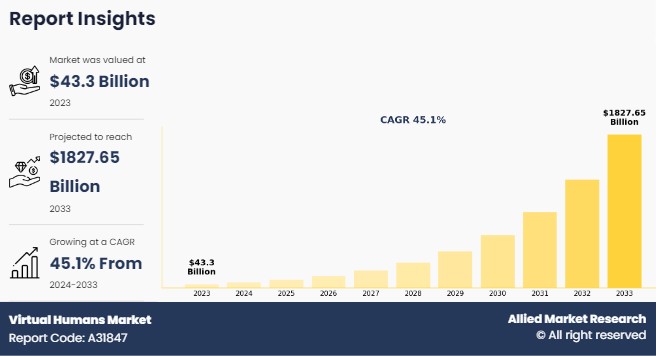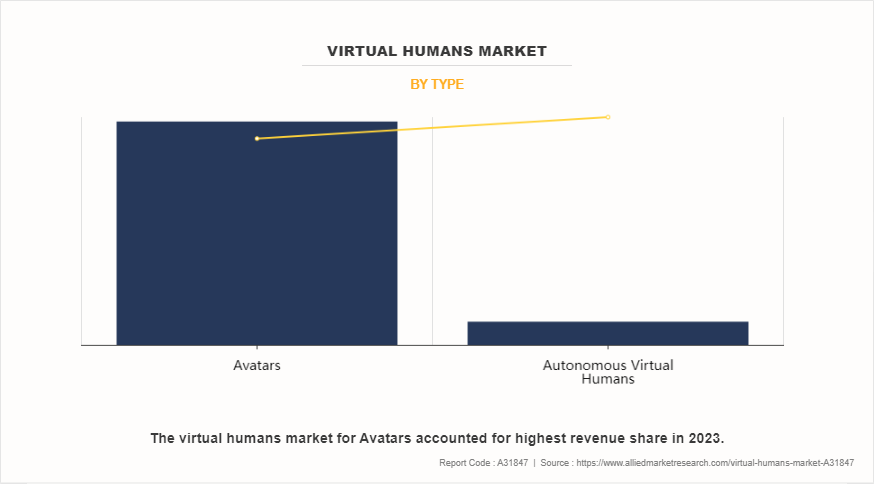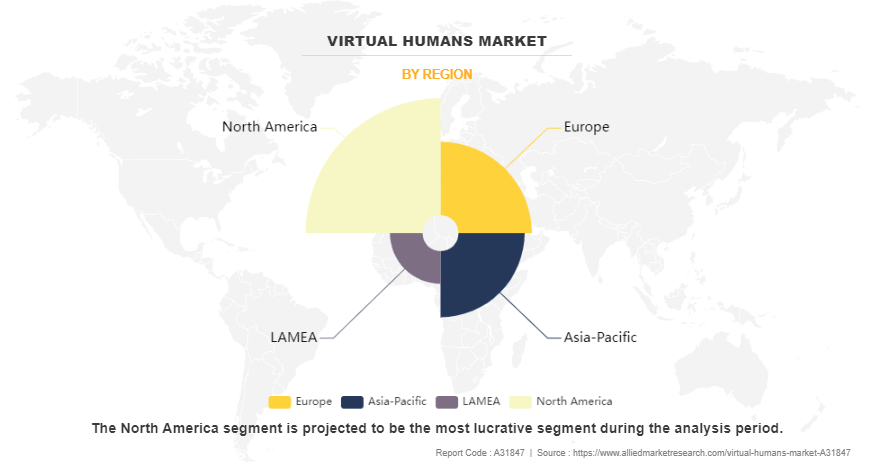Virtual Humans Market Insights, 2033
The global virtual humans market size was valued at $43.3 billion in 2023, and is projected to reach $1,827.65 billion by 2033, growing at a CAGR of 45.1% from 2024 to 2033. Computer representations of real people are known as virtual humans. These virtual digital avatars have been developed to explore the depiction, movement, and behavior of actual humans which evolve alongwith advancements in artificial intelligence (AI), ultimately enhancing machine-to-machine interactions. These AI-driven figures are designed to engage in discussions on relevant topics. They actively listen, respond, and interact with users within interactive simulations. After receiving training in specific content areas, virtual humans can hold open conversations with individuals, facilitating deeper learning experiences.

Key Takeaways
By type, the avatars segment held the largest share in the virtual humans market for 2023.
By industry vertical, the gaming and entertainment segment held the largest share in the virtual humans market for 2023.
Region-wise, North America held largest market share in 2023. However, Asia-Pacific is expected to witness the highest CAGR during the virtual humans market forecast period.
The expansion of virtual reality and augmented reality (VR and AR) drives the market growth by creating immersive environments where virtual humans can enhance user experiences across various sectors. Virtual humans play a pivotal role in facilitating realistic interactions and engaging content as businesses increasingly adopt VR and AR technologies for training, marketing, and entertainment. This integration allows companies to simulate real-world scenarios, improving training effectiveness and customer engagement. Furthermore, the demand for sophisticated virtual human interactions is expected to rise as consumers become familiar with these technologies. This, in turn, fuels innovation and investment in the virtual human market.
Segment Review
The virtual human market is segmented into type, industry vertical, and region. By type, it is classified into avatars and autonomous virtual humans. By industrial vertical, it is divided into BFSI, education, retail, healthcare, automotive, IT & telecommunications, gaming & entertainment and others. Region-wise, it is analyzed across North America, Europe, Asia-Pacific and LAMEA.
On the basis of type, the global virtual humans market share was dominated by the avatars segment in 2023 and is expected to maintain its dominance in the upcoming years, owing to growing demand for realistic interactions, advancements in animation technology, and applications across various industries such as gaming and entertainment, healthcare, education and retail. However, the autonomous virtual humans segment is expected to grow at the highest rate during the forecast period, owing to advancements in artificial intelligence, enabling self-learning capabilities, enhanced interactions, and increased applications in sectors such as healthcare, education, and customer service, which drives the segment growth.

Region wise, the virtual humans market was dominated by North America in 2023 and is expected to retain its position during the forecast period, owing to a robust technology infrastructure, significant investments in AI and machine learning, and a high demand for innovative customer engagement solutions. The presence of major tech companies and ongoing research initiatives further support the region's leadership in developing virtual human technologies. However, Asia Pacific is expected to witness significant growth during the forecast period, owing to rapid urbanization, increasing digitalization, and rising investments in AI technologies, which drives the virtual humans market in the region.

Competition Analysis
The report analyzes the profiles of key players operating in the virtual humans market such as pic Games, Inc., Inworld AI, Meta Platforms, Inc, Microsoft Corporation, Soul Machines, Unity Technologies, Alibaba Group Holding Limited, Aww Inc., UneeQ and Dexter Studios. These players have adopted various strategies to increase their market penetration and strengthen their position in the virtual humans market.
Recent Product Launch in the Virtual Humans Industry
- In February 2021, Epic Games, Inc., launched MetaHuman Creator, a new browser-based app that empowers game developers and creators of real-time 3D content to slash the time it takes to build digital humans from weeks or months to less than an hour, while maintaining the highest level of quality. MetaHuman Creator runs in the cloud via Unreal Engine Pixel Streaming. In addition to speeding up the complex process of digital human creation, it also enables teams of all shapes and sizes to more easily scale and make many types of characters to meet the demands of next-gen platforms and high-end virtual production.
- In February 2022, Alibaba created virtual influencer ‘Dong Dong’ for the Beijing Olympics. Her name translates to “winter” in Mandarin, which is fitting as she was created in partnership with the 2022 Beijing Winter Olympics. Alibaba created her to engage and connect with young, technologically literate fans. Dong Dong is not a typical virtual influencer, because she does not have her own social media profiles. Instead, she is a virtual brand ambassador who assists with online shopping.
- In January 2024, Unity Technologies acquired Ziva Dynamics, a company known for its digital character creation technology. The deal was announced at GamesBeat Next, the premier event for product leaders and leadership in the gaming industry. Unity plans to "democratize" Ziva's tools, making them easier to use for developers of all skill levels. The company's ZRT Trainer technology allows users to create people, animals, or similar items like cloth and have them deform in realistic ways.
Top Impacting Factors
Driver
Increased Focus on Personalization
Increased focus on personalization significantly drives the growth of the virtual human market, as it enables tailored and engaging interactions between virtual entities and users. Personalization allows virtual humans to adapt their responses, appearance, and behavior to individual user preferences, creating immersive and realistic experiences. This customization capability is crucial in various industries, such as healthcare, education, and customer service, where personalized interactions enhance user satisfaction and efficacy. For instance, virtual humans in customer service can provide relevant assistance by understanding specific user requirements, while in healthcare, they can offer tailored mental health support. Demand for personalized virtual human solutions continues to grow as consumers and businesses prioritize user-centric experiences. In addition, advances in artificial intelligence, machine learning, and natural language processing are further enabling virtual entities to better understand and respond to human emotions, improving the depth and quality of personalization. This trend not only increases engagement but also drives the virtual humans market size.
Restraints
High Development Costs
High development costs hinder the virtual humans market growth owing to the significant financial investment required for advanced technologies such as artificial intelligence, 3D modeling, and motion capture, which are essential for creating realistic and engaging virtual human experiences. Developing realistic and interactive virtual humans necessitates specialized expertise and resources, which can be prohibitively expensive for many organizations, particularly smaller companies with limited budgets. In addition, the ongoing costs of maintaining and updating these technologies can strain financial resources, leading to hesitancy in adopting virtual human solutions. Furthermore, integrating virtual humans into existing platforms, such as virtual reality and augmented reality environments, adds complexity and further escalates expenses. As a result, while larger enterprises may capitalize on the benefits of virtual humans, the high development costs present a considerable barrier to widespread adoption, ultimately decreasing the virtual humans industry.
Opportunity
Growth in E-learning and Remote Education
The growth in e-learning and remote education presents a significant opportunity for the virtual humans market. The need for interactive solutions that enhance student engagement becomes paramount as educational institutions and organizations shift towards online learning platforms. The virtual humans serve as intelligent teaching assistants, providing real-time feedback, answering questions, and guiding students through complex topics. In addition, the integration of virtual humans into e-learning platforms cater to diverse learning styles and preferences. By leveraging artificial intelligence and natural language processing, the avatars adapt the teaching methods to individual student requirements, ensuring a more personalized approach. This adaptability not only helps in improving knowledge retention but also fosters a more inclusive learning environment for students with varying abilities and backgrounds, which is driving the market growth.
Key Benefits for Stakeholders
This report provides a quantitative analysis of the market segments, current trends, estimations, and dynamics of the virtual humans market analysis from 2023 to 2033 to identify the prevailing virtual humans market opportunities.
The market research is offered along with information related to key drivers, restraints, and opportunities.
Porter's five forces analysis highlights the potency of buyers and suppliers to enable stakeholders make profit-oriented business decisions and strengthen their supplier-buyer network.
In-depth analysis of the virtual humans market segmentation assists to determine the prevailing market opportunities.
Major countries in each region are mapped according to their revenue contribution to the global market.
Market player positioning facilitates benchmarking and provides a clear understanding of the present position of the market players.
The report includes the analysis of the regional as well as global virtual humans market trends, key players, market segments, application areas, and market growth strategies.
Virtual Humans Market Report Highlights
| Aspects | Details |
| Market Size By 2033 | USD 1.8 trillion |
| Growth Rate | CAGR of 45.1% |
| Forecast period | 2023 - 2033 |
| Report Pages | 322 |
| By Type |
|
| By Industry Vertical |
|
| By Region |
|
| Key Market Players | Soul Machines, Aww Inc., Meta Platforms, Inc., Epic Games, Inc., DEXTER STUDIOS, UneeQ, Inworld AI, Unity Technologies, Alibaba Group Holding Limited, Microsoft Corporation |
Analyst Review
The increase in technologies such as machine learning and artificial intelligence enables virtual humans to support human activities in various environments. They efficiently manage multiple inquiries simultaneously and can address simple questions, making them invaluable in settings ranging from hospitals and offices to gaming and entertainment.
In addition, the increase in prevalence of virtual realities and the metaverse leads to rise in the utilization of virtual humans. The accelerated rollout of 5G and the ongoing research into next-generation wireless technology, including 6G, have further propelled the growth of the virtual human industry. These technologies enable virtual humans to engage in sophisticated, human-like interactions by accurately mimicking body language and facial expressions. In addition, tools such as machine learning and artificial intelligence play an important role in boosting the growth of the virtual human market.
Furthermore, the rise of the metaverse is opening new avenues for virtual humans, allowing them to serve as interactive guides, educators, or entertainers within virtual environments. This shift in the gaming industry, where developers are integrating advanced virtual characters that enhance player experiences and immersion, is further expected to drive the market growth. Moreover, advancements in natural language processing (NLP) improving the conversational abilities of virtual humans, make them more relatable and effective in various applications.
The virtual humans market involves the creation and use of highly realistic, AI-powered digital avatars that can simulate human interactions. These virtual beings are often used in entertainment, customer service, marketing, and even personal assistants.
The forecast period for the virtual humans market is 2024 to 2033.
The base year is 2023 in the virtual humans market.
The total market value of the virtual humans market was $43.3 billion in 2023.
The market value of the virtual humans market is projected to reach $1,827.65 billion by 2033.
Loading Table Of Content...
Loading Research Methodology...



